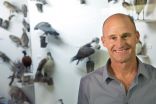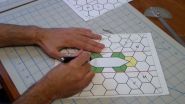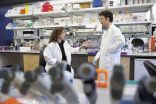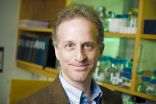INFORMATION:
The study was co-authored by researchers from institutions in Asia, Europe, North America, South America and Australia. Storz's research group included Juan Opazo and Federico Hoffmann, assistant professors at Universidad Austral de Chile and Mississippi State University, respectively.
Opazo and Hoffman formerly served as postdoctoral researchers at Storz's UNL laboratory. The three have also teamed with Chandrasekhar Natarajan, senior research associate of biology at UNL, to publish a new companion study in the journal Molecular Biology and Evolution.
Biologist gains insight into genetic evolution of birds
Part of international effort that sequenced the complete genomes of 45 avian species
2014-12-11
(Press-News.org) Lincoln, Neb., Dec. 11, 2104 -- A University of Nebraska-Lincoln researcher has contributed to discoveries about bird evolution as part of a new study that sequenced the complete genomes of 45 avian species.
Published Dec. 11 in the journal Science, the study found that avian genomes -- the complete archive of genetic material present in cells -- have exhibited surprisingly slow rates of evolution when compared with their mammalian counterparts.
Jay Storz, a Susan J. Rosowski Associate Professor of Biological Sciences, led a research group that assisted the study by examining the evolution of multi-gene families shared by birds and mammals. Each family comprises a collection of genes related to one another through a history of duplication, with all members of a given family descending from a single ancient gene.
Storz and his colleagues used computational methods to measure "gene turnover," the rate at which genes are gained or lost over time. The researchers reported that the rate of turnover in avian gene families is roughly two times slower than in mammals. This finding reflects a larger-scale pattern of evolutionary stasis in avian genomes, according to Storz.
"In mammals, there's this continual turnover -- it's like a genomic turnstile. With birds, it's far more conservative," Storz said. "There might be a gene family that consists of, say, 10 members in the common ancestor of birds and mammals. In mammals, that gene family has probably expanded and contracted in different lineages, and this results in dramatic differences in gene family size and membership composition among contemporary species. In birds, those 10 ancestral gene copies will remain intact and are inherited by all descendant lineages, so very little variation accumulates among species."
The lower rates of gene duplication in birds help account for the fact that avian genomes are typically much smaller and more streamlined than in mammals, Storz said.
Evolutionary biologists have long focused on gene duplication because it represents an important source of "evolutionary innovation," according to Storz. Though duplicated genes initially perform redundant functions, the copies that are retained sometimes adopt new functions or divide up ancestral responsibilities.
"One of the implications of the comparative genomic study is that there may be a reduced scope for evolutionary innovation among birds," he said. "Because there's a comparatively high rate of gene duplication among mammals, there are increased opportunities for these newly produced genes to evolve new functions."
Storz noted that complete genome sequences were previously available for only a few avian species. Adding 45 genomes to the mix, he said, represents an exponential leap in the amount of data available to evolutionary biologists.
"All of a sudden, we have this treasure trove," Storz said. "We were able to make some really informative comparisons because we now have extensive amounts of genomic data for different vertebrate species.
"The availability of these new avian genomes provides opportunities to address questions about the evolution of bird-specific characteristics in ways that weren't possible before."
ELSE PRESS RELEASES FROM THIS DATE:
Low income kids eat more fruits and vegetables when they are in school
2014-12-11
The fruits and vegetables provided at school deliver an important dietary boost to low income adolescents, according to Meghan Longacre, PhD and Madeline Dalton, PhD of Dartmouth Hitchcock's Norris Cotton Cancer Center and The Hood Center for Children and Families. In a study released in Preventive Medicine, Longacre and Dalton found that fruit and vegetable intake was higher among low income adolescents on days when they consumed meals at school compared to days when low income adolescent were not in school. The opposite was true for high income adolescents who consumed ...
Understanding how emotions ripple after terrorist acts
2014-12-11
PITTSBURGH--The 2013 Boston Marathon bombing motivated mass expressions of fear, solidarity, and sympathy toward Bostonians on social media networks around the world. In a recently released study, researchers at the University of Pittsburgh and Cornell University analyzed emotional reactions on Twitter in the hours and weeks following the attack.
The study is the first large-scale analysis of fear and social-support reactions from geographically distant communities following a terrorist attack. The findings show the extent to which communities outside of Boston expressed ...
Penn research outlines basic rules for construction with a type of origami
2014-12-11
Origami is capable of turning a simple sheet of paper into a pretty paper crane, but the principles behind the paper-folding art can also be applied to making a microfluidic device for a blood test, or for storing a satellite's solar panel in a rocket's cargo bay.
A team of University of Pennsylvania researchers is turning kirigami, a related art form that allows the paper to be cut, into a technique that can be applied equally to structures on those vastly divergent length scales.
In a new study, the researchers lay out the rules for folding and cutting a hexagonal ...
Happy-go-lucky CEOs score better returns
2014-12-11
A CEO's natural sunny disposition can have an impact on the way the market reacts to announcements of company earnings, according to research from the University of British Columbia's Sauder School of Business.
The study shows that leaders' inclinations to express themselves with optimism carries over into their tone when disclosing company performance - a tendency that can create an uptick in stock price.
"Ours is the first study to look at the effect of how managers naturally convey themselves," says Sauder Assistant Professor Jenny Zhang, who co-authored the paper. ...
Senescent cells play an essential role in wound healing
2014-12-11
Senescent cells have a bad-guy reputation when it comes to aging. While cellular senescence - a process whereby cells permanently lose the ability to divide when they are stressed - suppresses cancer by halting the growth of premalignant cells, it is also suspected of driving the aging process. Senescent cells, which accumulate over time, release a continual cascade of inflammatory cytokines, chemokines, growth factors and proteases. It is a process that sets up the surrounding tissue for a host of maladies including arthritis, atherosclerosis and late life cancer. But ...
Affluence, not political complexity, explains the rise of moralizing world religions
2014-12-11
The ascetic and moralizing movements that spawned the world's major religious traditions--Buddhism, Islam, Judaism, Hinduism, and Christianity--all arose around the same time in three different regions, and researchers reporting in the Cell Press journal Current Biology on December 11 have now devised a statistical model based on history and human psychology that helps to explain why. The emergence of world religions, they say, was triggered by the rising standards of living in the great civilizations of Eurasia.
"One implication is that world religions and secular spiritualities ...
Scientists map the human loop-ome, revealing a new form of genetic regulation
2014-12-11
EMBARGOED for release Thursday, Dec. 11, 2014, at 12 p.m. ET
HOUSTON - (Dec. 11, 2014) - The ancient Japanese art of origami is based on the idea that nearly any design - a crane, an insect, a samurai warrior - can be made by taking the same blank sheet of paper and folding it in different ways.
The human body faces a similar problem. The genome inside every cell of the body is identical, but the body needs each cell to be different -an immune cell fights off infection; a cone cell helps the eye detect light; the heart's myocytes must beat endlessly.
Appearing online ...
New targeted drugs could treat drug-resistant skin cancer
2014-12-11
Clinical trials to test the new drugs in patients should begin as early as 2015.
Existing drugs target faulty versions of a protein called BRAF which drives about half of all melanomas, but while initially very effective, the cancers almost always become resistant to treatment within a year.
The new drugs - called panRAF inhibitors - could be effective in patients with melanoma who have developed resistance to BRAF inhibitors.
The new study was funded by the Wellcome Trust and Cancer Research UK, and jointly led by scientists at The Institute of Cancer Research, ...
Getting antibodies into shape to fight cancer
2014-12-11
Scientists at the University of Southampton have found that the precise shape of an antibody makes a big difference to how it can stimulate the body's immune system to fight cancer, paving the way for much more effective treatments.
The latest types of treatment for cancer are designed to switch on the immune system, allowing the patient's own immune cells to attack and kill cancerous cells, when normally the immune cells would lie dormant.
In a study, funded by Cancer Research UK and published in the journal Cancer Cell, the Southampton team have found that a particular ...
Herpes virus rearranges telomeres to improve viral replication
2014-12-11
PHILADELPHIA - (Dec. 11, 2014) - A team of scientists, led by researchers at The Wistar Institute, has found that an infection with herpes simplex virus 1 (HSV-1) causes rearrangements in telomeres, small stretches of DNA that serve as protective ends to chromosomes. The findings, which will be published in the Dec. 24 edition of the journal Cell Reports, show that this manipulation of telomeres may explain how viruses like herpes are able to successfully replicate while also revealing more about the protective role that telomeres play against other viruses.
"We know ...
LAST 30 PRESS RELEASES:
Stardust study resets how life’s atoms spread through space
Practical education: Clinical scenario-based program development
The impact of family dynamics on eating behaviour – how going home for Christmas can change how you eat
Tracing the quick synthesis of an industrially important catalyst
New software sheds light on cancer’s hidden genetic networks
UT Health San Antonio awarded $3 million in CPRIT grants to bolster cancer research and prevention efforts in South Texas
Third symposium spotlights global challenge of new contaminants in China’s fight against pollution
From straw to soil harmony: International team reveals how biochar supercharges carbon-smart farming
Myeloma: How AI is redrawing the map of cancer care
Manhattan E. Charurat, Ph.D., MHS invested as the Homer and Martha Gudelsky Distinguished Professor in Medicine at the University of Maryland School of Medicine
Insilico Medicine’s Pharma.AI Q4 Winter Launch Recap: Revolutionizing drug discovery with cutting-edge AI innovations, accelerating the path to pharmaceutical superintelligence
Nanoplastics have diet-dependent impacts on digestive system health
Brain neuron death occurs throughout life and increases with age, a natural human protein drug may halt neuron death in Alzheimer’s disease
SPIE and CLP announce the recipients of the 2025 Advanced Photonics Young Innovator Award
Lessons from the Caldor Fire’s Christmas Valley ‘Miracle’
Ant societies rose by trading individual protection for collective power
Research reveals how ancient viral DNA shapes early embryonic development
A molecular gatekeeper that controls protein synthesis
New ‘cloaking device’ concept to shield sensitive tech from magnetic fields
Researchers show impact of mountain building and climate change on alpine biodiversity
Study models the transition from Neanderthals to modern humans in Europe
University of Phoenix College of Doctoral Studies releases white paper on AI-driven skilling to reduce burnout and restore worker autonomy
AIs fail at the game of visual “telephone”
The levers for a sustainable food system
Potential changes in US homelessness by ending federal support for housing first programs
Vulnerability of large language models to prompt injection when providing medical advice
Researchers develop new system for high-energy-density, long-life, multi-electron transfer bromine-based flow batteries
Ending federal support for housing first programs could increase U.S. homelessness by 5% in one year, new JAMA study finds
New research uncovers molecular ‘safety switch’ shielding cancers from immune attack
Bacteria resisting viral infection can still sink carbon to ocean floor
[Press-News.org] Biologist gains insight into genetic evolution of birdsPart of international effort that sequenced the complete genomes of 45 avian species



